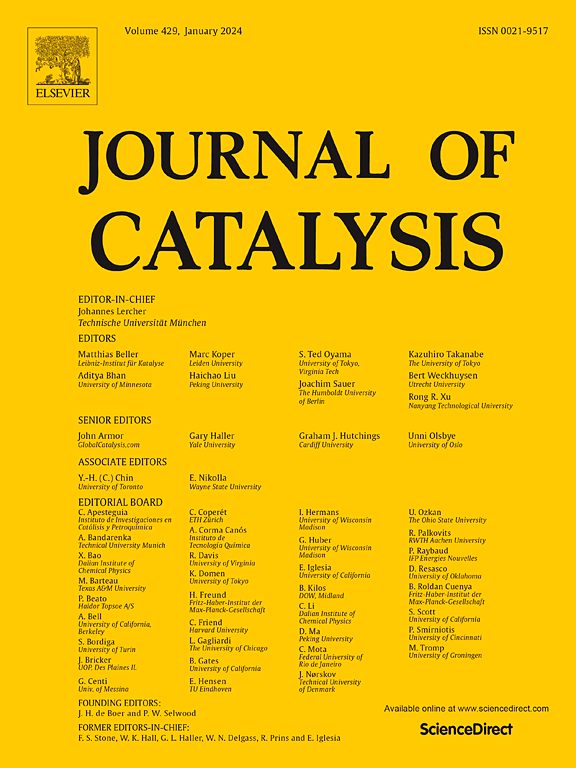RhI supramolecular assembly framework enables recyclable and thermal-stable catalysts for alkene functionalization
IF 6.5
1区 化学
Q2 CHEMISTRY, PHYSICAL
引用次数: 0
Abstract
The design of carrier-free recyclable catalysts is a key objective yet challenging task in modern catalysis. Here, we present the self-assembly of a nitrogen and phosphine-containing ligand (L) with RhI precusor to form a supramolecular assembly framework, (RhI2L2)n·X, as confirmed by NMR, ESI-MS and X-ray crystallographic analysis. This RhI supramolecular assembly framework can partially dissolve in solution at high temperatures and fully recover at room temperature, facilitated by π-π, C–H···π and electrostatic interactions, thereby adopting the merits of both homogeneous and heterogeneous catalysis. The inherent coordination mode of RhI2L2 enables this RhI supramolecular assembly framework to serve as an effective catalyst for promoting the hydroformylation and hydrosilylation of alkenes, with its practicality further demonstrated in a continuous-flow mini-plant, kilogram-scale hydroformylation of Fischtropsch C8 alkene, affording a turnover number of 1.27 × 105 over a 100-hour recycling period. In-situ high-pressure FTIR and DFT calculation elucidate the role of nitrogen and the dynamic evolution of catalytic resting state in the presence of syngas and alkene.


RhI超分子组装框架使可回收和热稳定的催化剂烯烃功能化
无载体可回收催化剂的设计是现代催化领域的一个重要目标,也是一项具有挑战性的任务。本文通过核磁共振、ESI-MS和X射线晶体学分析证实了含氮和膦的配体(L)与RhI前体的自组装,形成了一个超分子组装框架(RhI2L2)n·X。在π-π、C-H··π和静电相互作用的促进下,该RhI超分子组装框架可以在高温下部分溶解在溶液中,在室温下完全恢复,从而兼有均相催化和多相催化的优点。RhI2L2固有的配位模式使这种RhI超分子组装框架能够作为促进烯烃氢甲酰化和氢硅基化的有效催化剂,其可行性在连续流小型装置中得到进一步证明,Fischtropsch C8烯烃的公斤级氢甲酰化,在100小时的循环周期内提供1.27 × 105的周转率。现场高压FTIR和DFT计算阐明了氮气在合成气和烯烃存在下的作用和催化静息态的动态演化。
本文章由计算机程序翻译,如有差异,请以英文原文为准。
求助全文
约1分钟内获得全文
求助全文
来源期刊

Journal of Catalysis
工程技术-工程:化工
CiteScore
12.30
自引率
5.50%
发文量
447
审稿时长
31 days
期刊介绍:
The Journal of Catalysis publishes scholarly articles on both heterogeneous and homogeneous catalysis, covering a wide range of chemical transformations. These include various types of catalysis, such as those mediated by photons, plasmons, and electrons. The focus of the studies is to understand the relationship between catalytic function and the underlying chemical properties of surfaces and metal complexes.
The articles in the journal offer innovative concepts and explore the synthesis and kinetics of inorganic solids and homogeneous complexes. Furthermore, they discuss spectroscopic techniques for characterizing catalysts, investigate the interaction of probes and reacting species with catalysts, and employ theoretical methods.
The research presented in the journal should have direct relevance to the field of catalytic processes, addressing either fundamental aspects or applications of catalysis.
 求助内容:
求助内容: 应助结果提醒方式:
应助结果提醒方式:


